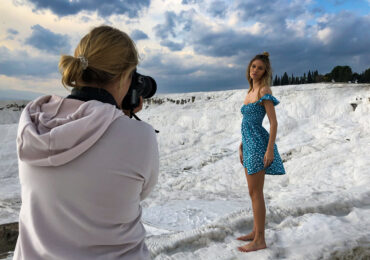Photographing Pamukkale, with its unique terraces and historical surroundings, offers a wealth of opportunities for capturing stunning images. Here are some photography tips to consider when visiting Pamukkale:

- Golden Hours: Make the most of the golden hours during sunrise and sunset. The soft, warm light during these times can create a magical atmosphere and enhance the texture and colors of the travertine terraces.
- Reflections: If there are pools of water on the terraces, use them to capture reflections of the surrounding landscape, especially during calm weather conditions.
- Wide and Close: Experiment with different focal lengths. Wide-angle shots can help you capture the vastness of the terraces, while close-up shots can showcase intricate details and textures.
- Rule of Thirds: Apply the rule of thirds to create visually appealing compositions. Position key elements, such as the terraces or historical structures, along the imaginary gridlines to add balance to your photos.
- Leading Lines: Utilize the natural lines of the terraces or pathways to guide the viewer’s eye through the image and create a sense of depth.
- People Perspective: Including people in your photos can provide a sense of scale and add a human element to the vast landscape. Try capturing people interacting with the environment.
- Details and Textures: Focus on capturing the unique textures of the travertine formations. Close-up shots of the mineral-rich water flowing down the terraces can yield intriguing abstract images.
- Panoramas: Consider capturing panoramic shots to convey the grandeur of the entire landscape. You can stitch multiple images together to create a wide, immersive view.
- Historical Elements: Integrate the ancient ruins of Hierapolis into your compositions. The juxtaposition of historical structures against the natural beauty can make for compelling images.
- Silhouettes: During sunset or sunrise, experiment with silhouettes by positioning subjects against the colorful sky. This technique can create dramatic and artistic visuals.
- Weather Conditions: Different weather conditions can drastically alter the mood of your photos. Cloudy days can provide soft, diffused lighting, while rain might result in reflections and a moody atmosphere.
- Respectful Photography: When photographing people, especially locals and visitors, always ask for permission before taking their photos to ensure you respect their privacy and cultural norms.
- Experimentation: Don’t be afraid to experiment with different angles, compositions, and settings. Take both wide shots to capture the entire scene and close-ups to highlight details.
Remember that Pamukkale is a protected UNESCO World Heritage site, so be sure to follow guidelines and respect the environment while taking your photographs. Your images can not only capture the beauty of the place but also tell a story of its history, culture, and natural wonders.
